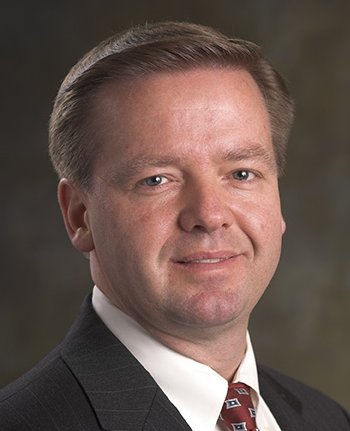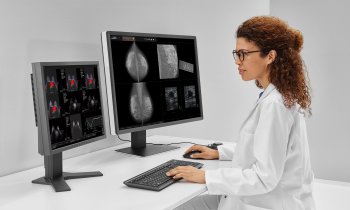Article • Breast and skeletal health
AI is proving pivotal in women’s health solutions
Pete Valenti, Hologic’s division president of breast and skeletal health solutions, talks about how Artificial Intelligence (AI) is driving innovation in breast health technology.
Report: Daniela Zimmermann
AI is proving pivotal as Hologic evolves its women’s health solutions. With a focus on breast and skeletal health, future steps will see the medical technology company incorporate a more integrated approach to drive better, more cost effective, outcomes that are clinically supported to deliver an improved patient experience. Underpinning that evolution more recently has been the acquisition of two organisations – digital specimen radiography specialists Faxitron Bioptics and BioZorb marker manufacturer Focal Therapeutics – as Hologic drives harder into the breast surgery side of that continuum.

Valenti explained: “One of the things that has always differentiated us - besides having superior clinical outcome data - is our ability to integrate.” From integrating biopsy into mammography to lead to lower costs and better outcomes, he indicates that the same direction will occur with surgery.
With Artificial Intelligence becoming increasingly important in healthcare, he points to it as being a key component in Hologic’s success in achieving higher rates of invasive cancer detection, coupled with lower rates of recall. “We have been doing Artificial Intelligence in our designs for years, we have an enormous database of breast cancers, and are constantly building on that database.” That, he suggests, makes finding cancer easier and faster for radiologists, and in particular via adding AI capability to tomosynthesis as a technique. “We are the only company that has a dense breast claim because when we designed our approach we thought about the future. That future is more risk stratified, or personalised medicine, and in that world density is a risk factor,” said Valenti. “Density makes it harder to see cancers, so by design how you find those things is again with AI. When you think about how AI fits with us, it fits along that spectrum and integrated design and Artificial Intelligence are that spectrum.”
The baseline should be much younger and that some patients should go (for mammography) every year, every other year or so and some every six months depending on their risk profile and history
Pete Valenti
AI can also perform the basics such as helping technicians do their job more efficiently, which ultimately sits within the cost equation alongside better patient experience and faster procedures within the workflow space. Valenti highlights Hologic’s Brevera® breast biopsy system with CorLumina® imaging technology in improving workflow on the biopsy side, as well as the patient experience and reducing retake and recall rates. “Retake rates and recall rates are enemies of faster workflow,” he added.
A major change he sees in the patient landscape over the next five years is the greater prevalence of available information and patients having more access to data about which providers deliver better detection and outcomes and which offer best value. He sees Hologic benchmarking that data via an analytics platform that is more predictive and will show outcomes and details such as comparisons in retake rates and which provider is best at reducing that.
Again, AI plays the pivotal role across the entire spectrum, he said, with algorithms and deep learning and the ability to learn and process on a continuous basis. “To do that we have to feed in the data – more cancers, more false positives – and that allows AI to determine differences between a positive and a false positive, so we are constantly adding much more data into the engine.” He sees an environment where AI will handle straightforward cases, leaving the radiologist to focus on more complex and unclear cases and also potentially eradicating the role of mandatory second reads in Europe, a move he suggests will lead to significant costs savings. “The more complex cases are going to need more radiologist attention but if a patient does not have to come back because they do not have the cancer then that improves the patient experience.”
The screening environment, he predicts, could shift with “risk stratification” – the watchwords. “The work we are doing with key partners on risk stratification and patient pathway is that the baseline should be much younger and that some patients should go (for mammography) every year, every other year or so and some every six months depending on their risk profile and history. Risk stratification is the world we are going to live in and that is an exciting world. By getting rid of some of pain associated with mammography, some (women) will want to go more because the experience is better.” He said Hologic, and its key partners, want to drive this process using data and clinical support.
One area Hologic is working on with a partner is a genomic testing model with mammography that can predict the cancer recurrence rate. If the model suggested that the recurrence rate with high probability was not going to be for 5-10 years then a patient would not need to come back so soon. Yet if it suggested a recurrence in two years, then a sooner re-examination could take place in order to pick up any possible recurrence at the earliest opportunity and improve survival rate. “That world is the world that is coming,” he continued, “and AI used in the patient pathway means we can ‘customise’ the journey with higher confidence.”
However, he stressed the importance of having a high number of cases to create the AI capability and revealed Hologic has plans to extend the concept from AI mammography to the world of ultrasound – working in partnership with Clarius - whilst continuing to expand its expertise within the breast diagnosis and therapeutics field. In terms of tomosynthesis and 3D mammography, he said Hologic is driving innovation faster than any other organisation and that is primarily because of the clear focus on breast care.
As for the future, he said an area of development is increased portability and also looking to integrate processes as well as the ability for health systems to better access patients away from a hospital setting. The aim, concluded Valenti, is to deliver improved outcomes and workflow as well as increase patient satisfaction as Hologic drives innovation in breast health technology.
23.01.2019










